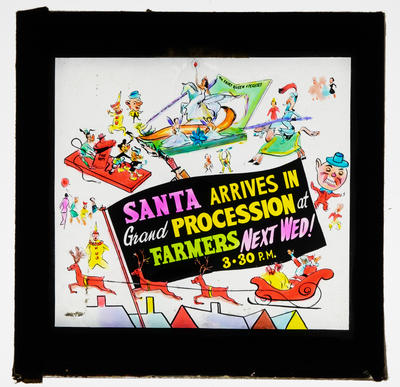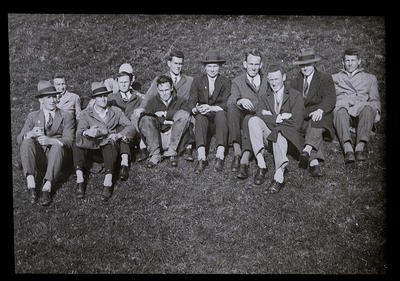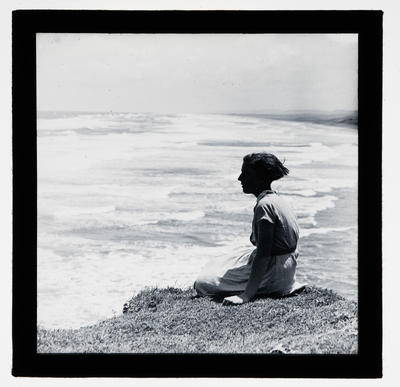Open access: Glass plate & lantern slide collection
Author: Freya Elmer
Rehousing & digitisation
The glass plates and lantern negatives had been in a backlog, mostly unprocessed. Despite not having a lot of information about this collection, their rich subject matter and condition made them a significant candidate for one of our collection care projects. The collection highlights the use of newly available photography technology in New Zealand used to capture life and the outdoors in the late 19th and early 20th centuries.
The collection was previously housed in our temperature-controlled store across a series of wooden or paper photograph boxes. Though these boxes were often the original housing for these objects, and are beautiful in their own right, it meant that the slides and negatives were at risk of environmental damage. This includes propelled degradation from dust or off-gassing by the wood, as well as emulsion damage from being in direct contact with one another.
The slides and negatives were first catalogued to our collection management system, Vernon. Once removed from their original housing, high-resolution images were captured in the Walsh Memorial Library’s in-house digitisation suite, using a lightbox and a mounted Sony digital camera. Creating digital surrogates helps us increase the collection’s accessibility by making the surrogate available for reuse visitors. What’s better is this also helps to preserve the originals by reducing handling.
For us, access was key for this collection given they are in the public domain and can now be used with ease — you don’t need permission for reuse, we just ask that you use the accompanying credit line shown on the record.
Once catalogued and digitised, items were individually rehoused into acid-free four-flap folders and stored vertically in custom archival boxes. This type of rehousing provides a buffer between the fragile glass slides and from the external environment. Each box is then stored in an environmentally controlled cool store to preserve them into the future.
What’s in the envelopes, you ask?
When the technology allowed, New Zealand’s photographers left their studios to capture the outdoors — some of which you can view in this collection. There are a number of images showing the cliffs and gannet colonies at Te Kauwae-a-Māui/Cape Kidnappers, a location where the Australasian gannet/takapu have been nesting since the 1870s.
I’m going to stick with the animal theme because who doesn’t love a good cat photo? In this collection you can find a whole range of animals — dogs, gannets, sheep and cows (a particularly great shot of Jerseys found here.)
Because these images are in the public domain they are also perfect for creating your own GIF. Try it yourself and you could even think about submitting your creation to GIF It Up — an annual competition to remix images digitised by the cultural heritage sector. (Definitely worth checking out previous winners!). You’ll also find plenty of images of New Zealand’s flora — ‘toi toi’, ‘kauri’, ‘fern’ or ‘bush’ are some of the searches you could try.
Of particular mention are the 21 images by Auckland-based photographer Josiah Martin. Martin was known for his topographical photography, especially the thermal regions, after delivering a lecture on the Rotomahana terraces to the Geological Society of London in 1883.
The Walsh Memorial Library hold some of Martin’s flora photography, which includes subjects such as this striking image of a silver fern. Martin was evidently taken by New Zealand’s landscape. Describing pohutukawa, he wrote ‘clumps of glossy green which, about the time of Christmas season, become glorious with a splendid profusion of crimson blossoms and soft white leaf buds.’ No wonder this tree has earned itself the title of New Zealand’s Christmas Tree.
In the lantern slide transparencies there are a range of advertisements capturing a particular era of New Zealand’s social history. This includes advertisements for the Farmers’ Santa Parade through Auckland’s CBD. This makes me lament, just slightly, knowing that 2019 was the last time we’d see Santa affixed to the side of Farmers. Au revoir!
There are also a wealth of images featuring unidentified people in them — such as this group of students in Māngere. As we have limited information about these images, often little more than what has been written on the caption of the glass slide, we’d love to hear from you if you recognise someone, something or somewhere in any of the images!
Like many museums, adding information to records is a continuous process and we value your contribution. You can either comment on the image on collections online or email us on library@motat.org.nz
The more enthusiastic among us can begin their search below.
References
• Department of Conservation. Cape Kidnappers/Te Kauwae-a-Māui Gannet Reserve. Date Accessed: 20 May 2021. https://www.doc.govt.nz/parks-and-recreation/places-to-go/hawkes-bay/places/cape-kidnappers-gannet-reserve/?tab-id=50578
• Gordon Maitland. 'Martin, Josiah', Dictionary of New Zealand Biography, first published in 1993. Te Ara - the Encyclopedia of New Zealand, https://teara.govt.nz/en/biographies/2m36/martin-josiah (accessed 26 May 2021).
• Hardwicke Knight. 1971. Photography in New Zealand : a social and technical history, 11-2812. Walsh Memorial Library, The Museum of Transport and Technology (MOTAT).
• New Zealand History. History of New Zealand photography', URL: https://nzhistory.govt.nz/culture/nz-photography, (Ministry for Culture and Heritage), updated 5-Aug-2014.






![[Black and white glass plate negative cat in a field]; Unknown; Early 20th Century](https://collection.motat.nz/records/images/medium/6373/d9b27ea3b50b9d0037f42277b248ebdd4ef92118.jpg)